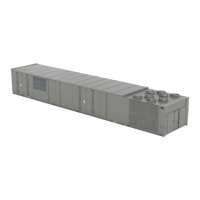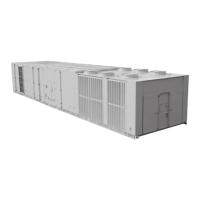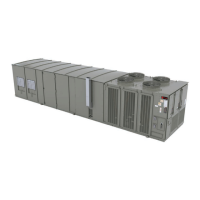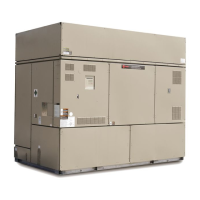RT-SVX073A-EN
43
WARNING
Explosion Hazard!
Failure to properly regulate pressure could result in a
violent explosion, which could result in death, serious
injury, or equipment or property-only-damage.
When using dry nitrogen cylinders for pressurizing
units for leak testing, always provide a pressure
regulator on the cylinder to prevent excessively high
unit pressures. Never pressurize unit above the
maximum recommended unit test pressure as
specified in applicable unit literature.
Access holes are provided on the unit as illustrated in to
accommodate a side or bottom pipe entry.
Following the guidelines listed below will enhance both the
installation and operation of the furnace.
Note: In the absence of local codes, the installation must
conform with the American National Standard Z223-
1a of the National Fuel Gas Code, (latest edition).
1. To assure sufficient gas pressure at the unit, use Table
13, p. 44 as a guide to determine the appropriate gas
pipe size for the unit heating capacity listed on the unit
nameplate.
2. If a gas line already exists, verify that it is sized large
enough to handle the additional furnace capacity
before connecting to it.
3. Take all branch piping from any main gas line from the
top at 90 degrees or at 45 degrees to prevent moisture
from being drawn in with the gas.
4. Ensure that all piping connections are adequately
coated with joint sealant and properly tightened. Use a
piping compound that is resistant to liquid petroleum
gases.
5. Provide a drip leg near the unit.
6. Install a pressure regulator at the unit that is adequate
to maintain 7" w.c. for natural gas while the furnace is
operating at full capacity.
Important: Gas pressure in excess of 14" w.c. or 0.5
psig will damage the gas train.
NOTICE
Gas Valve Damage!
Failure to follow instructions below could result in
gas valve damage from incorrect gas pressures,
irregular pulsating flame patterns, burner rumble, and
potential flame outages.
Use a pressure regulator to properly regulate gas
pressure. DO NOT oversize the regulator.
Failure to use a pressure regulating device will result in
incorrect gas pressure, which can cause erratic
operation due to gas pressure fluctuations as well as
damage the gas valve. Oversizing the regulator will
cause irregular pulsating flame patterns, burner rumble,
potential flame outages, and possible gas valve
damage.
If a single pressure regulator serves more than one
rooftop unit, it must be sized to ensure that the inlet gas
pressure does not fall below 7" w.c. with all the
furnaces operating at full capacity. The gas pressure
must not exceed 14" w.c. when the furnaces are off.
7. Provide adequate support for all field installed gas
piping to avoid stressing the gas train and controls.
WARNING
Explosion Hazard!
Failure to follow safe leak test procedures below
could result in death or serious injury or equipment or
property-only-damage.
Never use an open flame to detect gas leaks. Use a
leak test solution for leak testing.
8. Leak test the gas supply line using a soap-and-water
solution or equivalent before connecting it to the gas
train.
9. Check the supply pressure before connecting it to the
unit to prevent possible gas valve damage and the
unsafe operating conditions that will result.
Note: Do not rely on the gas train shutoff valves to
isolate the unit while conducting gas pressure/
leak test. These valves are not designed to
withstand pressures in excess of 14" w.c. or 0.5
psig.
Connecting the Gas Supply Line to the
Furnace Gas Train
Follow the steps below to complete the installation between
the supply gas line and the furnace. Refer to Figure 27, p.
45 and Figure 28, p. 45, for the appropriate gas train
configuration.
1. Connect the supply gas piping using a “ground-joint”
type union to the furnace gas train and check for leaks.
2. Adjust the inlet supply pressure to the recommended 7"
to 14" w.c. parameter for natural gas.
3. Ensure that the piping is adequately supported to avoid
gas train stress.
4. If the through the base gas opening is used, seal off
around the pipe and the 3" water dam. If the through
the base gas opening is not used, the 3" opening
should be sealed shut to prevent indoor air leakage.
Installation

